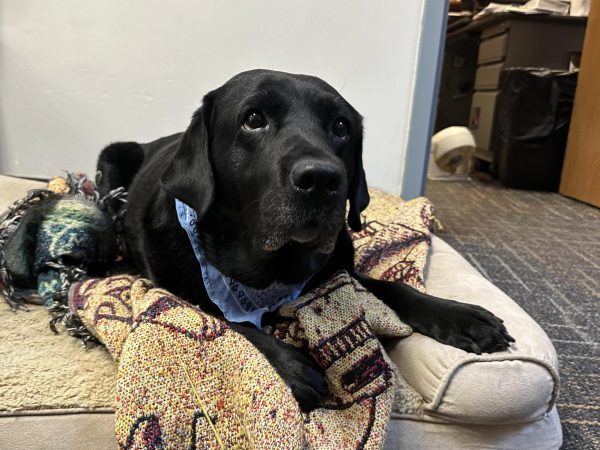When people think of “helpers” they usually think about other people. What many people don’t usually consider when thinking about “helpers” are service animals. Service animals play an important role in helping many people all over the world. Although they often are underappreciated in the big scheme of things, service \animals are spectacular at the jobs they perform and the wonderful things they do for people. Sometimes a furry friend can do things that other people normally can’t!
At Libertyville High School the usage of service and support dogs is widely supported by staff and students alike. Service animals play a role in providing aid to students. They are working animals specially trained to assist pe
ople in need of specialized aid. Legally, all schools including LHS allow for students to bring their own service dogs on campus. Having service dogs at LHS encourages students to perform their best, and feel secure while at LHS. One student at LHS, senior Felix Nakanant, has a service dog named Daisy. Daisy is a golden retriever who aids Felix. “[Daisy’s] job is to help me get through the hallway and navigate and so I don’t get really flustered, in crowds and stuff like that. And she’s been a very big help… with high school, also, feeling safe physically.” Felix says. LHS provides a good environment for Felix and Daisy as well, “[the school has] been very good about paperwork and stuff like that, and then making sure that [Daisy’s] good….” said Felix.

LHS also has its own support dog: Wrigley. “She is a facility animal or support animal, so she does get trained every year and certified to do the work. She spent about six months training specifically for this job when she came to us.” said Mr. Loika, her owner and main handler at LHS. Wrigley is a support dog that students can, and are actually encouraged, to interact with. In fact, the main reason Wrigley was brought in was to decrease stress and aid students emotionally. “The school district had been talking about incorporating some therapy dog support animals into the school, I think, mostly out of some of the research that was going on, but also that other schools were utilizing a dog in the building more regularly than just typical times that schools bring in support animals, like during finals, or if there’s something that happens at the school where that might be helpful, that’s usually a time where lots of you know, dogs would make their way into schools.” Mr Loika said. Wrigley is well-loved throughout LHS for her service with students. Her beneficial impact can be seen by the many smiles that emerge around her while she walks through the hallways, and when, in the words of Mr Loika, “certain packs of students come in and out to give her a little scratch.”

Support dogs such as Wrigley and Daisy are vastly different from regular pet dogs. “Daisy is specially trained to help me with basic needs, and she’s trained specifically for my disability. She’s different from a regular pet dog. Pet dogs, you can train them and stuff like that. But [Daisy] was trained with a trainer to specifically help me in my everyday life. Pet dogs are more so enjoyable, just like at home or just on walks and stuff like that.” said Felix. A stark difference between support dogs and the average pet dog is, as mentioned by Felix, that support dogs serve a certain role in providing some sort of assistance for their owners. Additionally, the reason why support animals are so helpful is because they are trained for providing aid to people. Many support dogs, such as Wrigley, go through training prior to even being adopted by a family.
Furthermore there are many more types of service and support dogs. These other types of support dogs include hearing dogs, autism service dogs, guide dogs, seizure alert dogs, psychiatric service dogs, emotional support dogs and Post Traumatic Stress Disorder (PTSD) dogs. Some service dogs are even used by the police, such as search and rescue dogs. Most of the dogs listed above are trained specifically for being a service dog, such as police dogs. However, some support dogs, such as emotional support dogs, don’t undergo special training in order to provide assistance to their owner. In a world where mental health awareness and disability awareness is increasing, sometimes just seeing a sweet furry friend who’s there for you is the motivation people need to get through their day. This is where the line between service dogs, support dogs, and pet dogs really gets drawn. To summarize, pet dogs are exactly that- your average four legged pet. Meanwhile service dogs go through high levels of specific training in order to provide assistance, and support dogs may receive a low amount of training but still serve a specific purpose in terms of assistance.
Nonetheless, these wonderful and supportive animals can be found all over the United States and are growing in popularity. Service animals benefit our community on a personal level. Because of the amazing things service animals do, they also deserve to be treated with respect and kindness. Something as small and simple as being gentle with service animals, and allowing them to do their job can really help make a beneficial difference!






